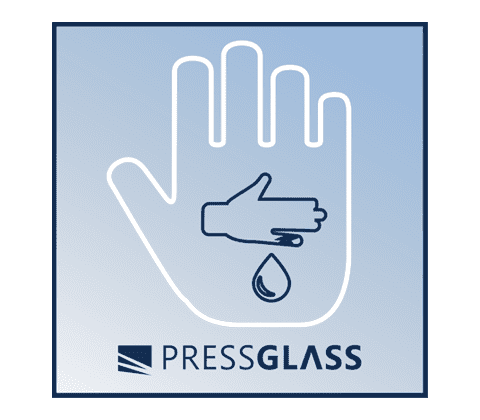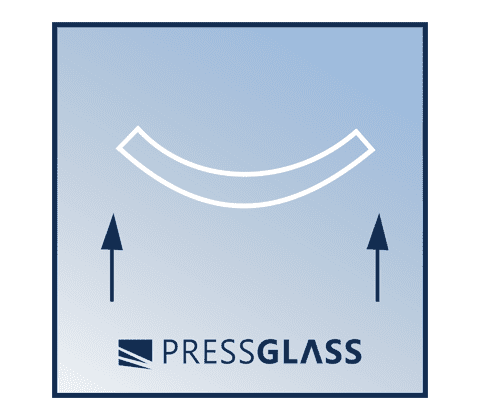Fully Tempered Glass
Glass is naturally fragile. Thanks to the tempering process, the internal stresses within its structure change, which results in an increase in its bending strength. Tempered glass means safety. When it breaks, the pane is shattered into tiny pieces with blunt edges. This characteristic makes tempered glass particularly suited for use in highly sensitive places, with a high risk of being broken or exposed to high insolation – which means a big increase of internal thermal stresses.
Advantages
Protection Against Injury from Breaking Glass
In order to prevent such danger PRESS GLASS proposes 2 types of solutions:
- tempered glass, which after being hit breaks into small particles of blunt edges, or
- laminated safety glass, which thanks to its construction remains in its frame or bolted elements after the impact of a blow or smashing
All of our tempered glass units fulfil the norms of EN 12600 specifications.
High Level of Resistance to Bending
Architects are still searching for more aesthetic materials which are used to make supporting elements. Glass construction is also becoming more commonly used as supporting elements. Glass fins, glass stairs, glass floors are only a few examples of such applications. All these possibilities came into being thanks to the development of methods regarding tempering glass. Now, construction elements made of monolithic glass can be put under significant strain of bending and pressurizing.
Resistance to Thermal Shock
Glass is naturally fragile. Thanks to the tempering process, the internal stresses within its structure change, which results in an increase in its bending strength. This characteristic makes tempered glass particularly suitable for use in highly sensitive places, with a high risk of being broken or exposed to high insolation – which means a big increase of internal thermal stresses.
Market Offering Includes Glass:
| Glass thickness | Minimum dimensions | Maximum dimensions |
| 3/16″ – 3/4″ (5mm – 19mm) | 4″ x 12″ | 126″ x 236″ |
Directional Tempering
An unavoidable component of the tempering process is roller waves. PRESS GLASS informs all Customers that this effect can occur, in order to be fair in service. The waviness effect is of particular importance if glass panes are assembled in building facades, especially with big insulated surfaces.
Roller waves can been seen in distortion of the view reflected in the facade. To decrease the distortion effect of a reflected picture, it is suggested that directional tempering is made. It means that e.g. in the case of tempering along the height, waviness will occur perpendicularly to this dimension.
Heat Strengthened Glass
Heat strengthened glass differs from tempered glass by the kind of breakage that occurs during glass pane damage. Due to its breaking characteristic, the pane assembled in the frame stays there after the damage, which protects against injury.
Thanks to this feature, thermally strengthened glass is starting to become interesting as an alternative for tempered. However, thermally strengthened glass is not ranked among the types of safety glass.
| Glass thickness | Minimum dimensions | Maximum dimensions |
| 3/16″ – 3/4″ (5mm – 19mm) | 4″ x 12″ | 126″ x 236″ |
Heat Soak Testing
The manufacturing process of float glass is done by the smelting of separate ingredients. Molten glass is poured out over a bath of liquid tin, and then formed to the required thickness in a floating process and then annealed, where it cools down. There is a risk during this process that inclusions of nickel sulfide will occur. This phenomenon causes an increase of internal stress in the tempered glass, which could lead to self-breaking.
Even though this phenomenon occurs extremely rarely, one must allow for this possibility. It is suggested that the tempered glass is put under a pre-heating process, during which the glass panes which have pollution content are eliminated from the shipment. The PRESS GLASS company offers the possibility of carrying out an extra glass check by means of the Heat Soak Testing method.
Edge Processing
Depending on the Customer’s request, before starting the tempering process, the glass must undergo the machining process i.e. cutting, drilling, grinding or grinding and polishing together. Tempered safety glass can not undergo further fabrication.
All requirements must be presented together with the order for tempered glass. If there is no additional description all tempered glass panes up to 8mm in thickness are produced by PRESS GLASS with blunt edges. Glass panes which are thicker than 8 mm have matte ground edges.






